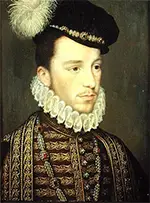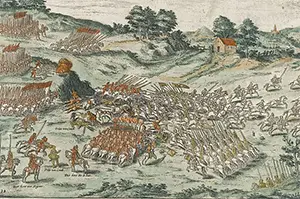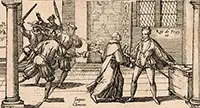The French King Henry III
King Henry III ruled France during the latter part of the 16th Century, while his realm was inflamed by religious warfare. 
He was born on Sept. 19, 1551 at the Royal Château de Fontainebleau in Paris. His father was the reigning monarch, King Henry II, and his mother was Catherine de Medici. Henry was the fourth son of the king and queen and so probably had no expectation of ever being king himself. However, his older brother Louis died and then both his older brothers Francis and Charles became king but died childless. Thus, when Charles IX died in May 1574, Henry was the designated heir to the French throne. Despite his status as the fourth son (or perhaps because of it), Henry was the favorite son of his mother. She made no compunction about showering him with kind words and kind deeds, long after he was old enough to make his own decisions. He had interests different from those of his father and brothers. They liked hunting and the outdoors; Henry preferred fencing if we was involved in an active pursuit and reading and studying art if he wanted more quiet pastimes. While Henry was growing up, he witnessed the events that marked a religious war within France and across Europe. Most European countries were ruled by monarchs who professed to the Catholic faith. England was a noted exception, as were certain German states. But within most European countries thrived a minority, sometimes large, of members of Protestant (or not Catholic) faiths. In France, the most notable of these were the Huguenots. 
Intense struggles between these people and the Catholic-leaning monarchs and royals in France predated Henry's reign. He also participated in several battles in this long-running, often violent struggle. Named commander in chief of the royal armies in 1567, Henry led royal troops against Huguenot forces at the Battles of Jarnac (right) and Moncontour, both in 1569, and played an indirect role in the assaults that made up the St. Bartholomew's Day Massacre, a five-day purge of Huguenots in 1572. He had further angered Protestants by ordering the execution of the Protestant leader the prince of Condé, who had been captured at Jarnac. In July of 1572, the King of Poland, Sigismund II Augustus, died. By popular acclaim, Henry was named as the next Polish monarch. He had to agree to uphold religious tolerance in the Polish realm; he did so and was crowned on Feb. 21, 1574. Just three months later, his brother Charles, who had been on the French throne since 1560, died, leaving no heir. Henry agreed to come home to rule France and left Poland to its own devices in terms of selecting a new ruler. France crowned him King Henry III on Feb. 13, 1575 at Reims. Two days later, he married Louis of Lorraine; they had no children. The country was still in the throes of the religious wars at this point. Henry tried to keep the peace by issuing the Edict Beaulieu, which made it possible for Huguenots to follow their own worship procedures in public. Catholics in France and elsewhere were none too happy with this pronouncement; the powerful French Catholic Henry I, Duke of Guise, formed the Catholic League as a result. Henry had a brother who was younger than he was. When Henry became king, that brother, Francis, became the Dauphin. Francis died on June 10, 1584, and Henry had no children. Thus was named Henry of Navarre as Dauphin. Henry had a bloodline connection to the throne, as a descendant of King Louis IX; he was also married to Margaret of Valois, sister of King Henry III. However, Henry of Navarre was also a Protestant and, to Catholics the worst kind, a Huguenot. The Wars of Religion dragged on, with no end in sight. Neither side was willing to endorse a truce or compromise unless it meant complete happiness for that particular side. On May 12, 1588, a Catholic force under the leadership of the Duke of Guise marched into Paris, in what came to be called the Day of the Barricades. Henry fled the city. A few months later, on December 23, Henry invited the Duke of Guise to a meeting at the Château de Blois. Also invited was the duke's brother, Louis II, Cardinal of Guise. Unbeknownst to either brother, they had walked into a trap. Henry's men killed both brothers and also imprisoned the duke's son. The outrage in Paris was palpable: The king had ordered the execution of two very popular leaders and two very popular Catholics. He found himself at opposition with Parlement as well and retired to Tours, where he set up his parliament. He also allied himself fully with the Dauphin, who commanded a |
|
Social Studies for Kids
copyright 2002–2025
David White



 considerable armed force. The two Henrys banded together and marched on Paris. On Aug. 1, 1589, the king was staying at Saint-Cloud, preparing for battle. A Dominican friar entered the royal presence, saying that he possessed documents that the king had to see. When pressed, the friar demanded a word alone with the king, who agreed. The friar then stabbed the king in the abdomen. Royal guards killed the friar quickly, but the wound proved to be fatal. Henry III died the next day. He was the last of the House of Valois. His successor, Henry of Navarre, became
considerable armed force. The two Henrys banded together and marched on Paris. On Aug. 1, 1589, the king was staying at Saint-Cloud, preparing for battle. A Dominican friar entered the royal presence, saying that he possessed documents that the king had to see. When pressed, the friar demanded a word alone with the king, who agreed. The friar then stabbed the king in the abdomen. Royal guards killed the friar quickly, but the wound proved to be fatal. Henry III died the next day. He was the last of the House of Valois. His successor, Henry of Navarre, became 
